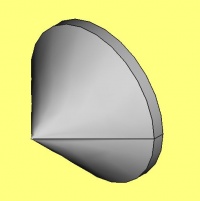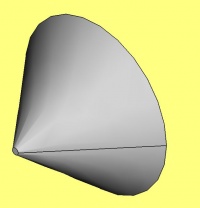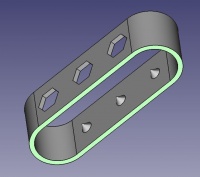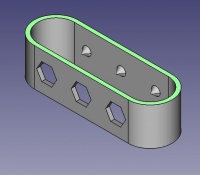Toothbrush Head Stand/fr: Difference between revisions
(Created page with "=== Arrondir les coins === * Enfoncer la touche Ctrl {{KEY|CTRL}} click sur les quatre arrêtes verticales .") |
(Created page with "N'hésitez pas à vous aider en changeant le mode d'affichage Barres tâches (en haut) onglet "Affichage, ligne "Style de représentation , Choisir "Filaire File: DrawStyl...") |
||
| Line 143: | Line 143: | ||
* Enfoncer la touche Ctrl {{KEY|CTRL}} click sur les quatre arrêtes verticales . |
* Enfoncer la touche Ctrl {{KEY|CTRL}} click sur les quatre arrêtes verticales . |
||
N'hésitez pas à vous aider en changeant le mode d'affichage |
|||
| ⚫ | |||
Barres tâches (en haut) onglet "Affichage, ligne "Style de représentation , Choisir "Filaire |
|||
| ⚫ | |||
[[File:TBHS-17.JPG|800px|center]] |
[[File:TBHS-17.JPG|800px|center]] |
||
Revision as of 09:51, 26 March 2018
| Topic |
|---|
| Modeling |
| Level |
| Beginner |
| Time to complete |
| 1 hour |
| Authors |
| EmmanuelG |
| FreeCAD version |
| 0.16 or greater |
| Example files |
| Thingiverse 2403310 |
| See also |
| None |
Un problème de la vie courante
Les brosses à dents électriques viennent rarement avec une tête, tandis que dans une famille, vous verrez souvent plusieurs têtes utilisées avec un seul moteur. Beaucoup de personnes confrontées à un problème commun nous conduisent à une variété de solutions, comme vous pouvez le voir sur Thingiverse (200 à 800 projets sont liés à cela). Voici la première réponse et comment la concevoir.
Ce tutoriel vous guidera à travers les étapes nécessaires pour modéliser la partie montrée dans l'image ci-dessous en utilisant les outils de base du Part Design Workbench (beaucoup d'outils et de capacités ne sont pas couverts).
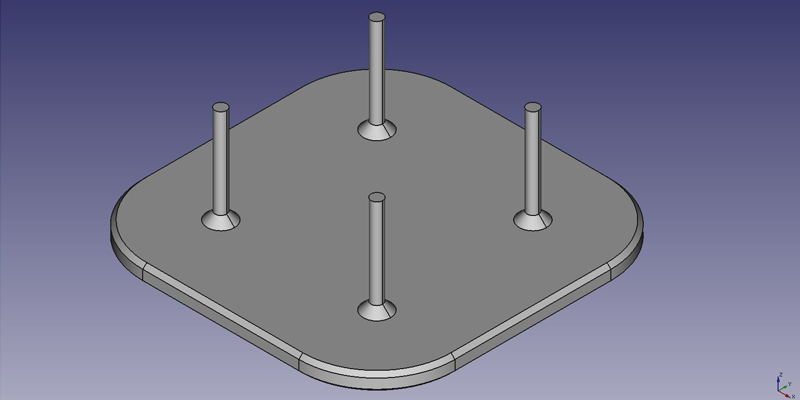
Première idée: un plateau
- A partir de la page d'accueil, sélectionnez
 Part Design ou créez un nouveau document et sélectionnez l'espace de travail Part Design .
Part Design ou créez un nouveau document et sélectionnez l'espace de travail Part Design .
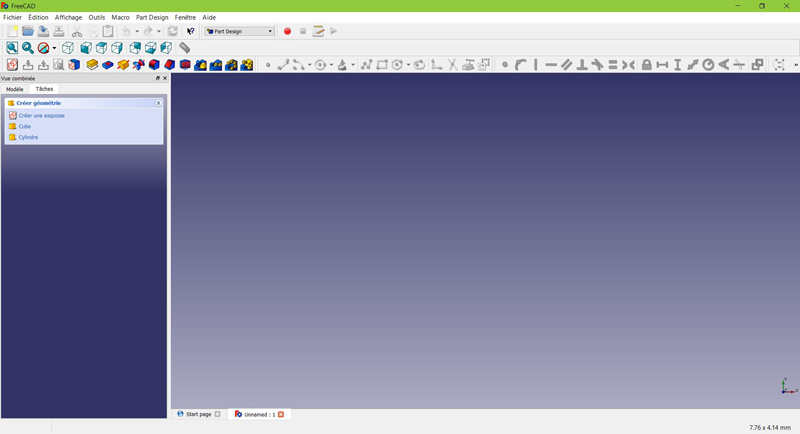
Créer une esquisse
- Cliquez sur
 'Nouvelle esquisse' . Soit à partir du menu de tâches contextuelles à gauche, soit de la barre d'outils ci-dessus ou du menu Part Design en haut.
'Nouvelle esquisse' . Soit à partir du menu de tâches contextuelles à gauche, soit de la barre d'outils ci-dessus ou du menu Part Design en haut.
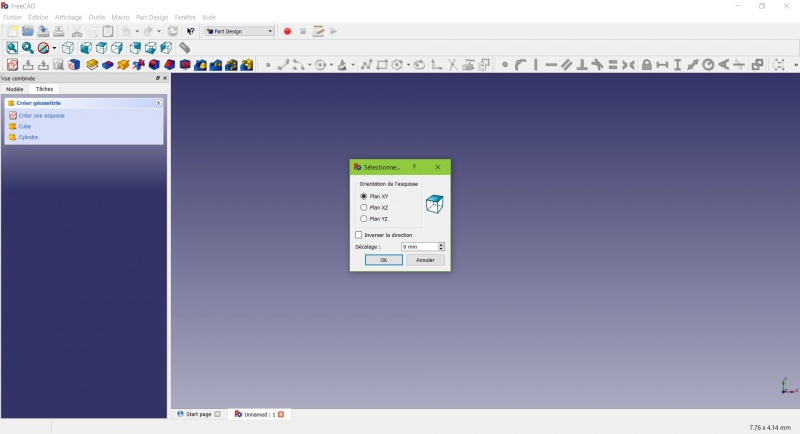
Une boîte de dialogue vous invite à choisir l'orientation de l'esquisse et à fournir un décalage.
- Nous allons sélectionner le plan XY comme indiqué dans l'image ci-dessus (cette orientation correspond à la plaque de construction commune de la plupart des imprimantes 3D), puis cliquez sur OK.
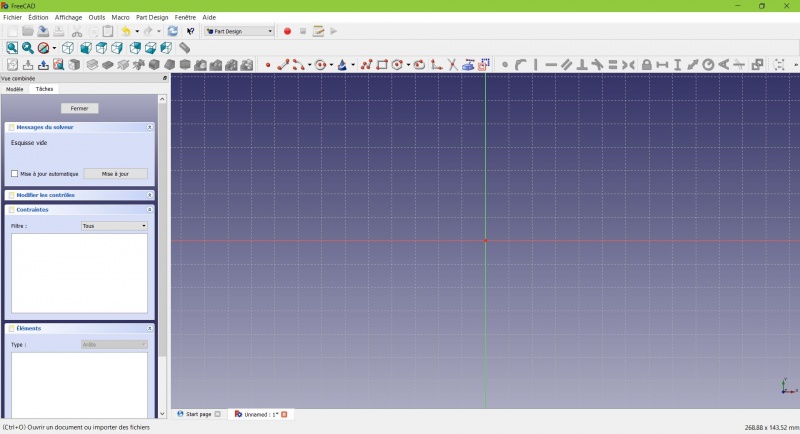
Vous êtes maintenant face au plan XY d'en haut, et avez accès aux outils de dessin.
Cliquez sur'Rectangle' .
- Cliquez pour placer un premier point.
- Cliquez pour placer le coin opposé.
- Appuyez sur ESC ou cliquez sur le bouton droit de la souris pour arrêter d'utiliser l'outil.
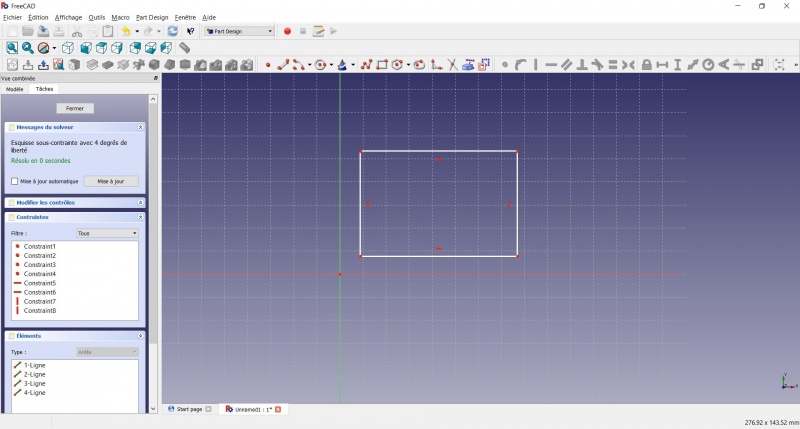
Vous avez maintenant un rectangle mobile de dimensions non spécifiées.
Cliquez sur une ligne du rectangle, vous avez maintenant accès aux outils de contrainte à droite de la barre d'outils (en fonction de la taille de votre écran, vous devrez peut-être les faire glisser vers la gauche pour les voir tous)
- Cliquez sur
 Longueur '
Longueur ' - Une boîte de dialogue vous invite à définir une dimension. Entrez 80mm, cliquez sur OK.
- Répétez avec l'autre côté du rectangle, également 80mm.
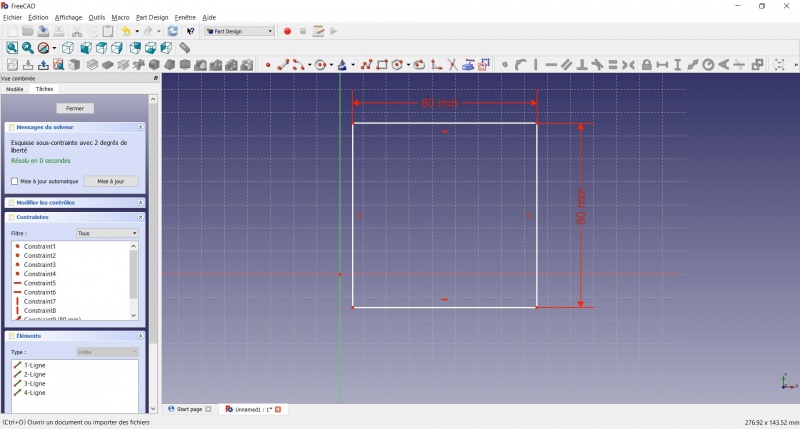
Maintenant vous avez un carré mobile de 80mm de coté
* Cliquez sur le point en bas à gauche du carré.
- Cliquez sur l'origine du plan XY (à l'intersection des deux lignes épaisses).
- Cliquez sur
 'Coincident' .
'Coincident' .
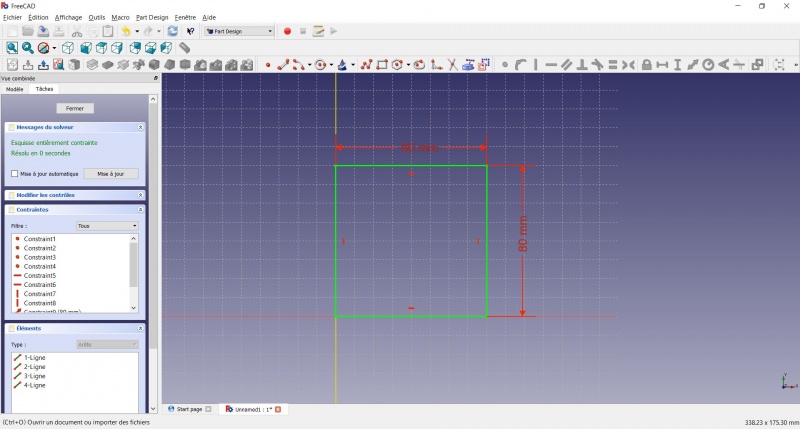
Vous avez maintenant un croquis totalement contraint, comme vous le dit le solveur sur la gauche et le changement de couleur (vert) dont un des sommets est confondu avec l'origine des axes XOY et les cotés horizontaux et verticaux.
C'est une bonne pratique de toujours avoir un croquis totalement contraint.
Un croquis sous-contraint peut laisser place à des changements non désirés, si vous modifiez quelque chose plus tard. Au contraire, un croquis trop contraint n'est pas bon non plus. Dans ce cas, le solveur vous avertit des contraintes redondantes et vous devez supprimer certaines d'entre elles.
- Pour quitter l'esquisse, cliquez sur le bouton "Fermer" à gauche ou sur l'icône
 dans la barre d'outils, ou appuyez sur ESC, ou bouton droit de la souris (gauche pour gauchers).
dans la barre d'outils, ou appuyez sur ESC, ou bouton droit de la souris (gauche pour gauchers).
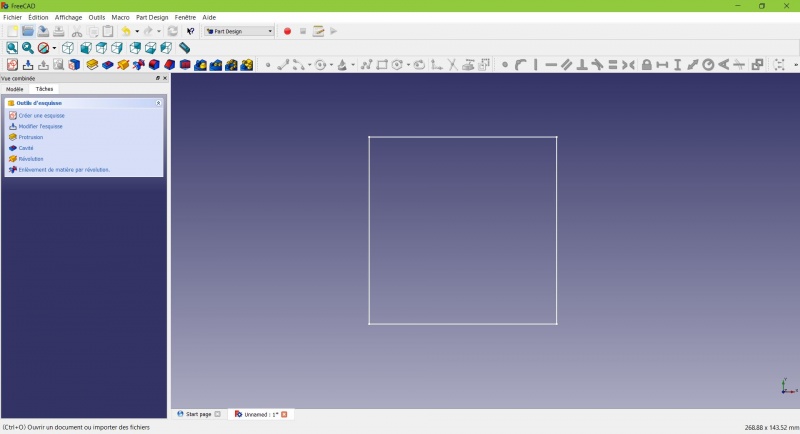
Vous ne voyez maintenant que le carré et le menu contextuel de gauche vous montre plus d'options qu'avant.
Créer un volume (pad)
- Cliquez sur
 'Axonométrique' parmi les vues standard, pour mieux voir ce qui va se passer.
'Axonométrique' parmi les vues standard, pour mieux voir ce qui va se passer. - Cliquez sur
 'Pad' .
'Pad' . - Entrez 4mm et cliquez sur OK.
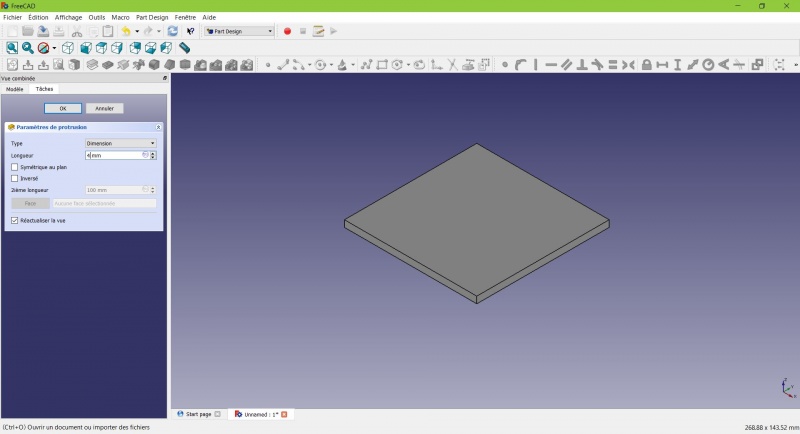
Votre carré est désormais un volume !
Créer un nouveau dessin sur une face
- Sélectionner la face supérieure
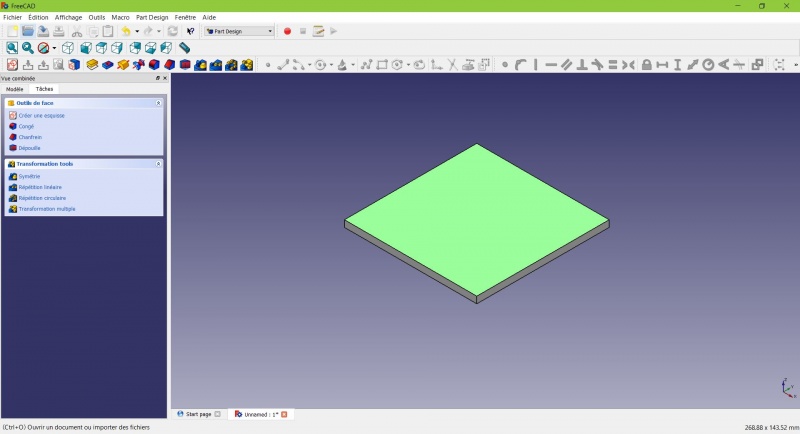
La couleur de la face change (seulement la face doit changer de couleur, pas tous le volume) et vous avez plus d'options dans le menu contextuel
- Cliqur sur
 New sketch. Comme une face a été sélectionnée, il ne vous demandera pas de choisir un plan.
New sketch. Comme une face a été sélectionnée, il ne vous demandera pas de choisir un plan.
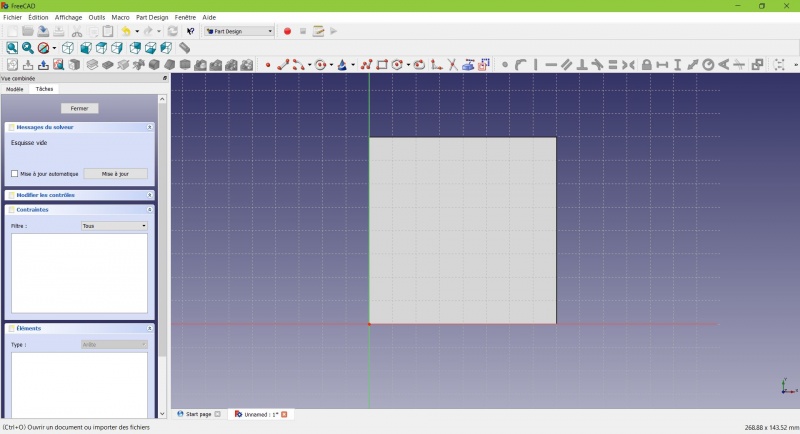
- Cliquez sur
 'Circle]', cliquez pour placer le centre, déplacez le pointeur et cliquez pour définir le rayon.
'Circle]', cliquez pour placer le centre, déplacez le pointeur et cliquez pour définir le rayon. - Dessinez 4 cercles sur la face (de n'importe quelle taille)
- Appuyez sur ESC ou cliquez sur le bouton droit de la souris pour arrêter d'utiliser l'outil (cercle).
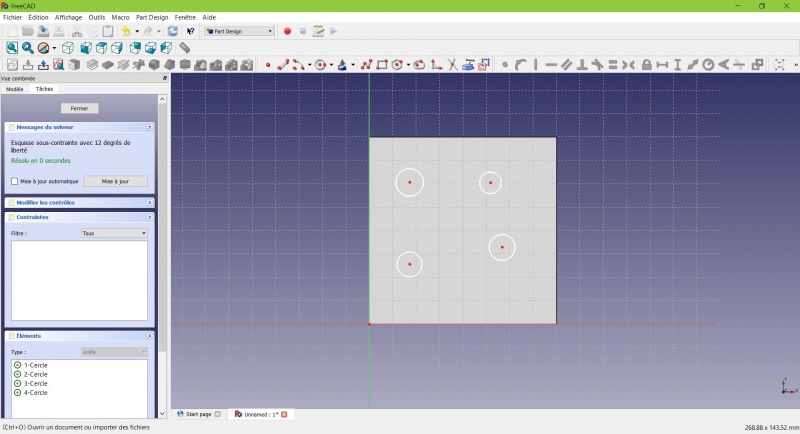
- Sélectionnez les cercles (un par un en maintenant la touche Ctrl enfoncée)
- Cliquez sur le bouton "Rayon de la barre de contraintes et répopndre "oui" à la boite de dialogue demandant si les cercles doivent être égaux
 'Equal Length'
'Equal Length'
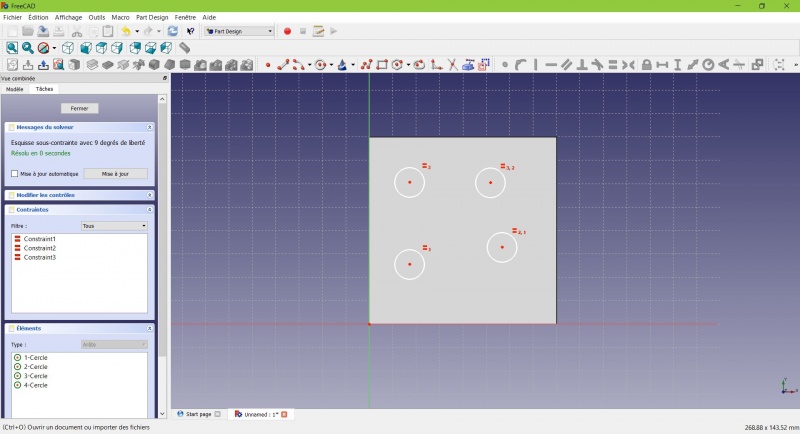
Maintenant les cercles ont le même rayons
- Cliquez sur
 'Géométrie externe' .
'Géométrie externe' . - Cliquez sur les quatre côtés du carré, les arêtes deviendront couleur magenta.
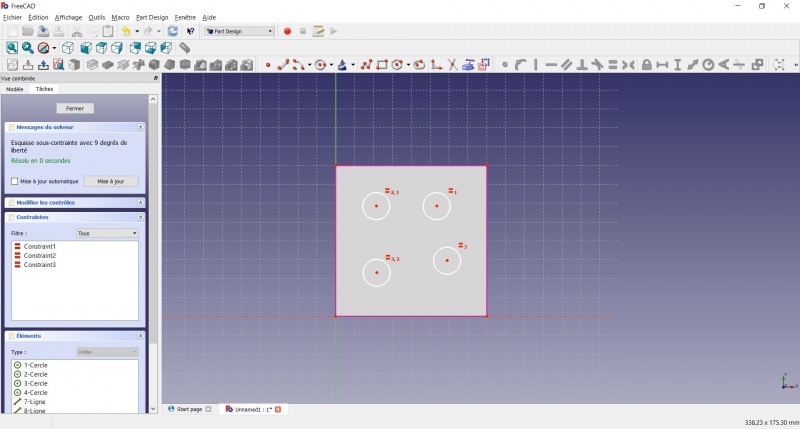
Ces lignes seront les références pour positionner les cercles
- Utiliser la contrainte de longueur
 Length pour les positionner à 20mm des angles.
Length pour les positionner à 20mm des angles.
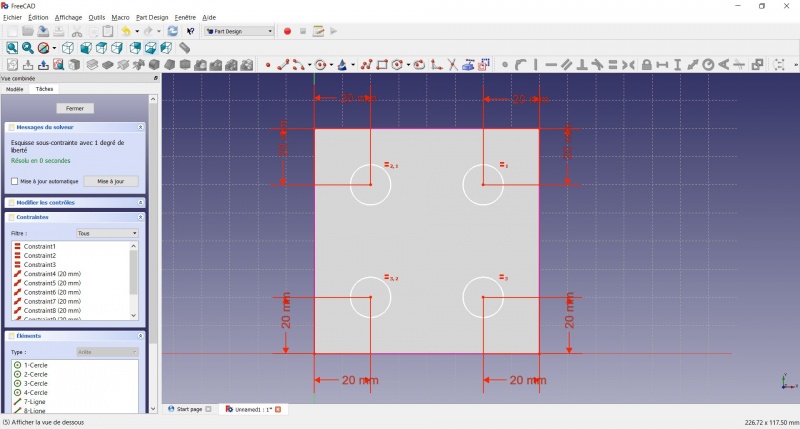
- Cliquer sur un cercle
- Cliquer sur le bouton "Rayon
 Radius et donner la valeur 1,5mm.
Radius et donner la valeur 1,5mm.
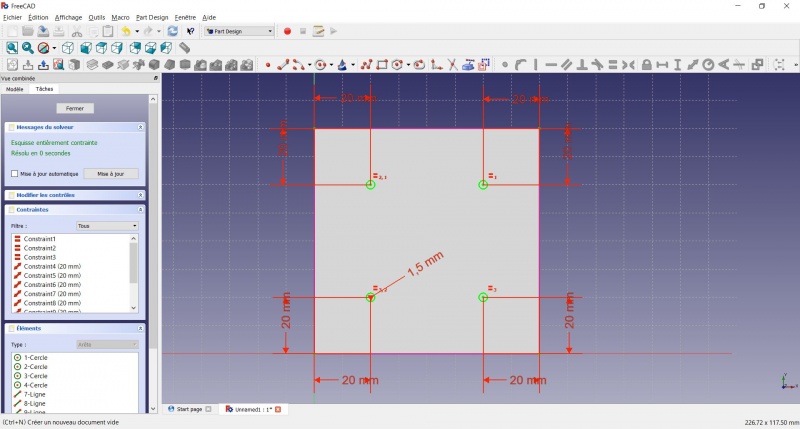
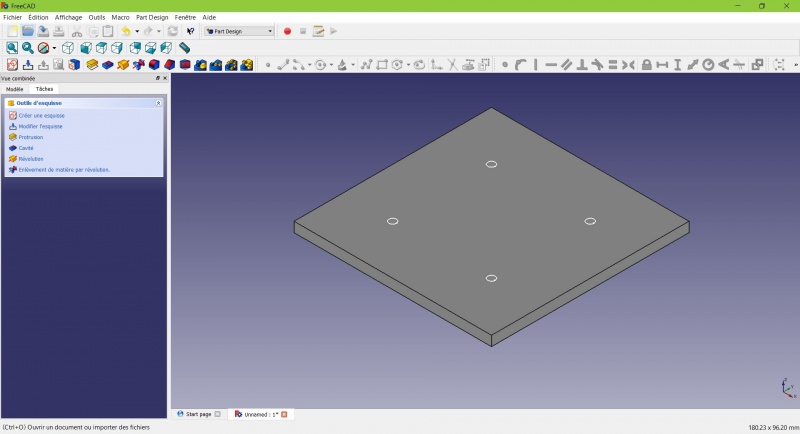
Créer un volume
- Click sur
 Axonometric en vue standard, pour mieux voir ce qui se passe devant vos yeux ébahis.
Axonometric en vue standard, pour mieux voir ce qui se passe devant vos yeux ébahis. - Click sur
 Pad.
Pad. - Entrer 25mm et click OK.
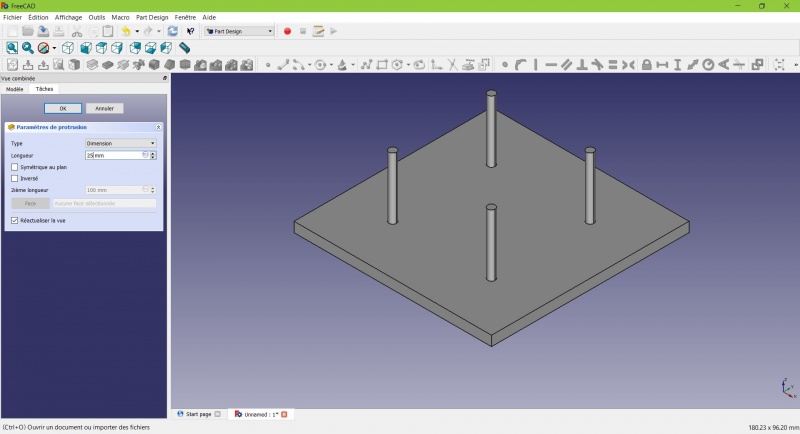
Vous avez la forme de base, juste une touche finale....
Arrondir les coins
- Enfoncer la touche Ctrl CTRL click sur les quatre arrêtes verticales .
N'hésitez pas à vous aider en changeant le mode d'affichage Barres tâches (en haut) onglet "Affichage, ligne "Style de représentation , Choisir "Filaire
'Wireframe' et
'Filaire et ombre' .
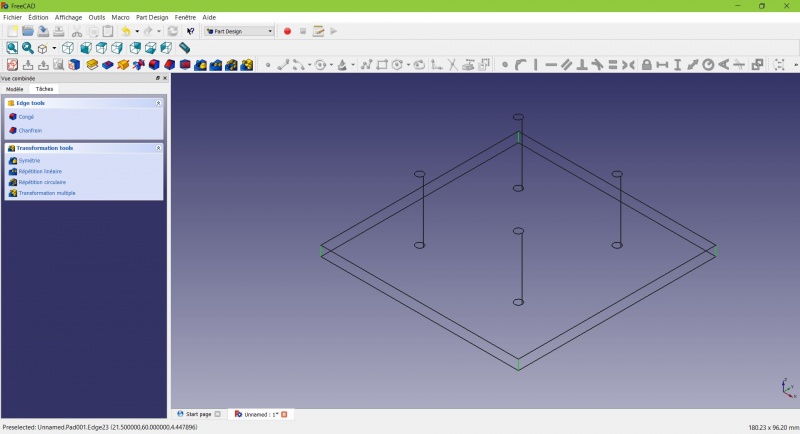
- Click on
 Fillet.
Fillet. - Set the radius at 20mm.
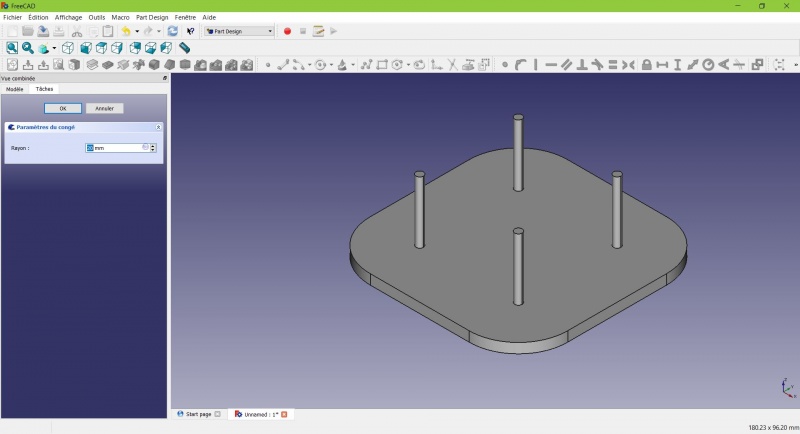
Much better.
Making it more robust
We need to add material at the base of the cylinders to make them less prone to snap. Because of the printing orientation these small surfaces will be fragile at the junction with the base.
- Select the circles at the base of the cylinders
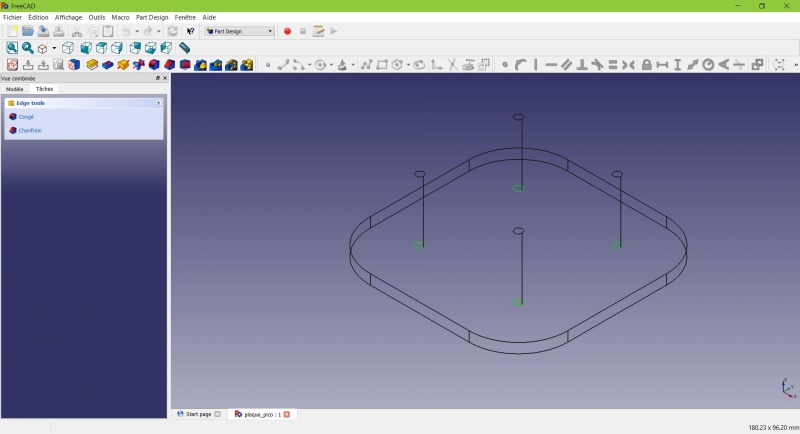
- Click on
 Chamfer.
Chamfer. - Set it to 2mm.
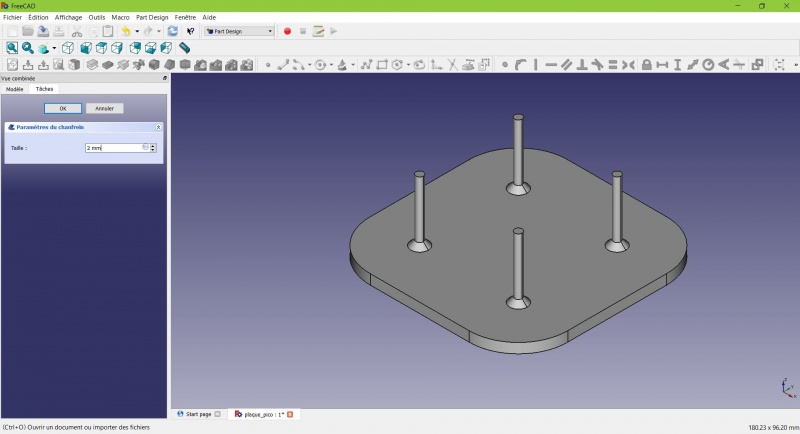
Chamfer the edges
The first layer of plastic is often being squashed a little too much, this will compensate that and save you time in cleaning the model. If the first layer is ok that will make it only nicer
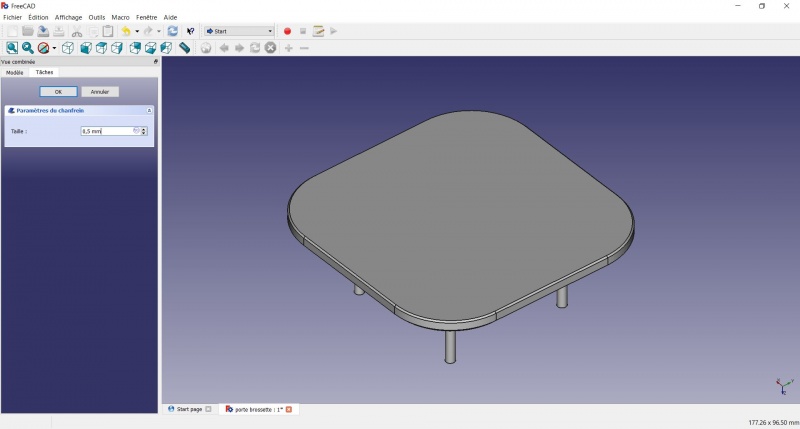
- Select the edges at the border of the upper face (holding CTRL ).
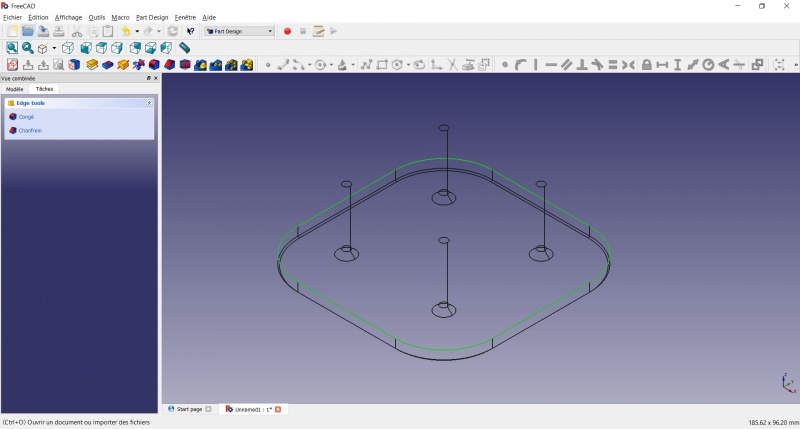
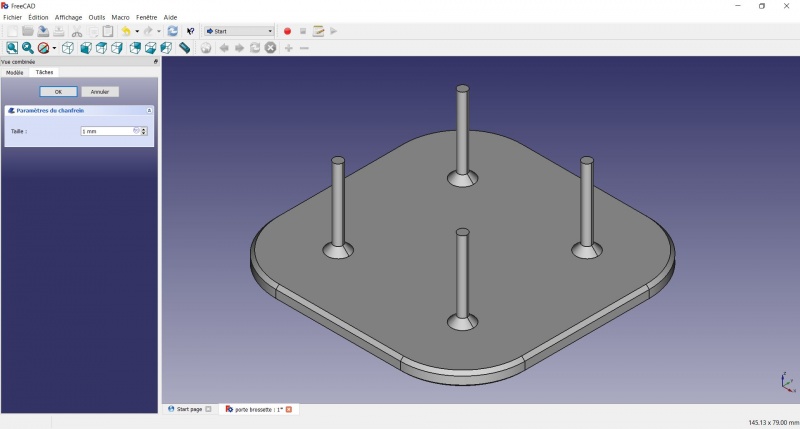
Tadaa !
Export as a .STL
- In the Combo View on the left, select the tree view instead of the contextual task menu, click on the last feature (the chamfer).
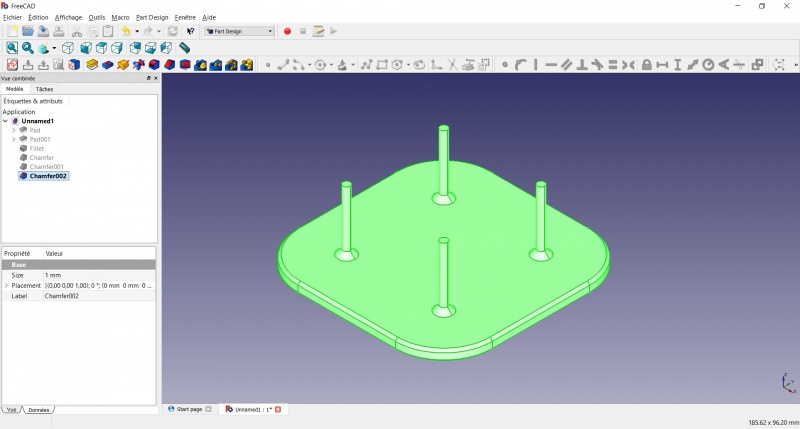
- Now you can select "Export..." from the File menu at the top left, and select the file format .STL.
- Just print it :-)
Inspiration
The above model make a good starting point to use FreeCAD, but as a toothbrush head stand it have its flaws : due to the print orientation and small surface the sticks are prone to break.
Inspired by the variety of solutions other people came up with, we will make this second version which will be much better.
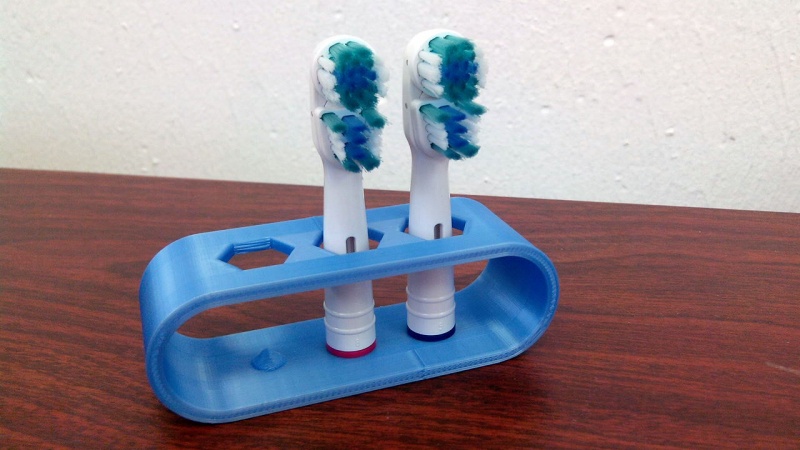
Don't worry it is often needed to go through several revision for an idea (e.g. : once the prototype on the picture was used, we added more space between the heads so that they should not touch).
In this second part you will also learn to use more tools, like the powerful Linear repetition.
Second idea : a band
Create a sketch

- Draw a
 Slot
Slot
- Click to place the first center
- Move to define the length and radius
- Click to set the second center.
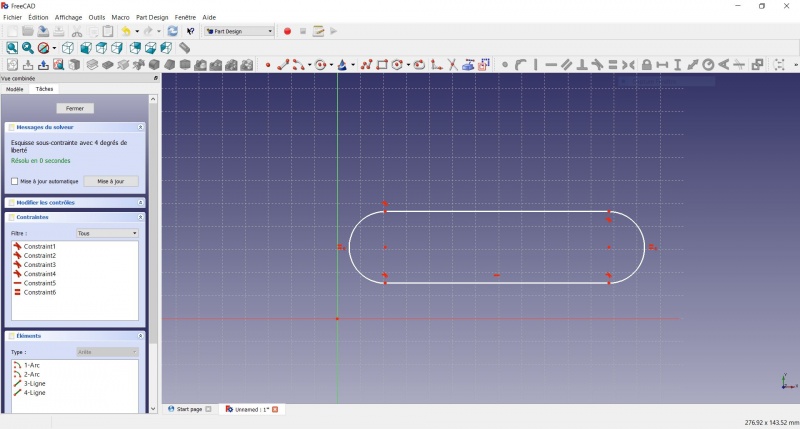
You now have a floating slot of unspecified dimensions.
- Click on one of the horizontal line of the slot
- Click on
 Length
Length - A dialog prompts you to set a dimension. Enter 75mm, click OK.
- that's for a 3 head stand, count 25mm for each, if you want more
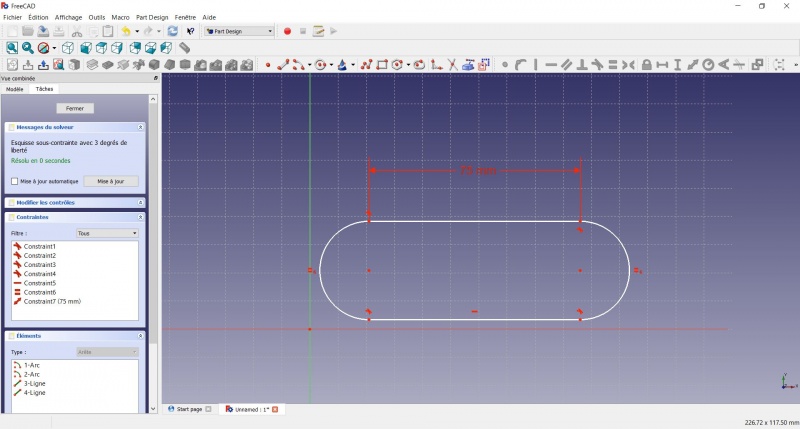
- Click on one point of the horizontal line
- Click on one point of the other horizontal line
- Click on
 Length
Length - A dialog prompts you to set a dimension. Enter 29mm, click OK.
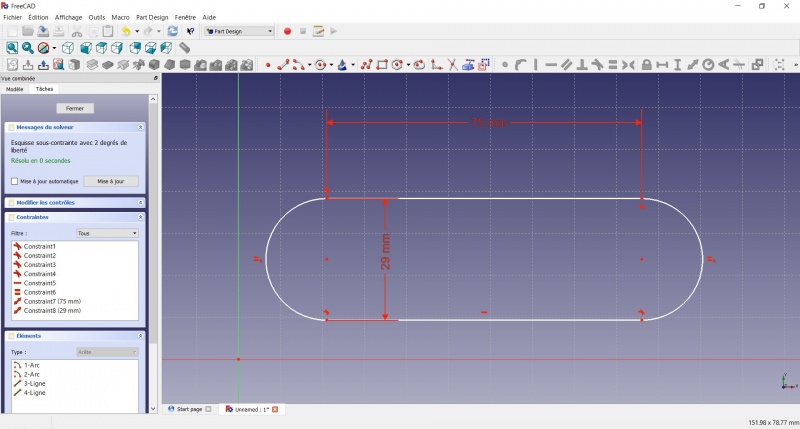
- Draw a
 Slot around the first slot.
Slot around the first slot.
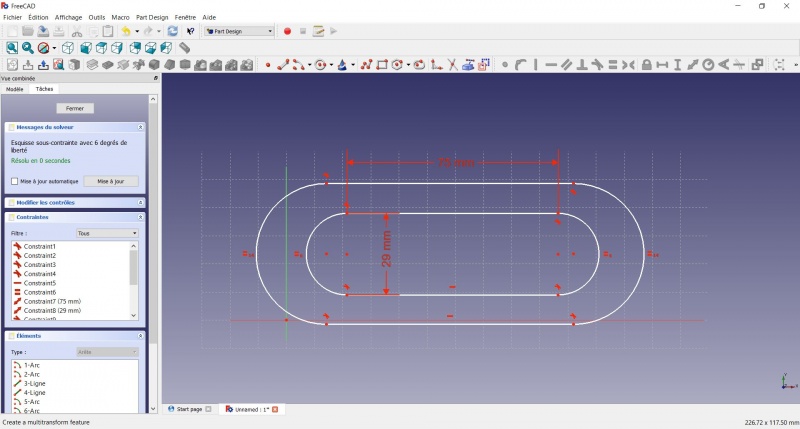
- Make the centers of the second slot coincident with the centers of the first slot with
 Coincident.
Coincident.
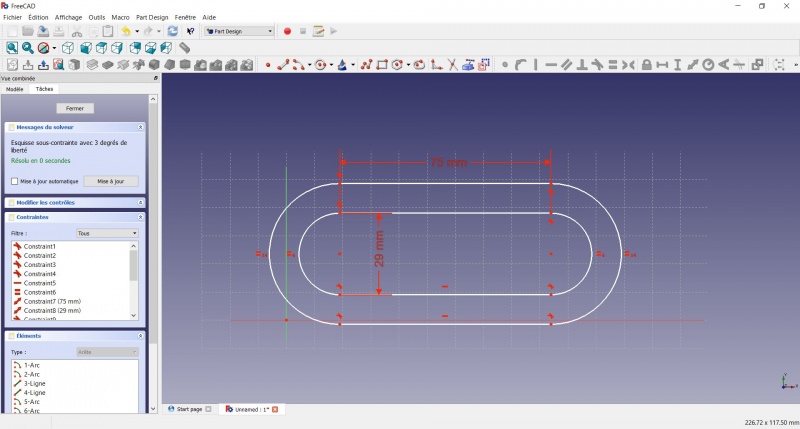
- Click on one point of the horizontal line of the first slot
- Click on one point of the nearest horizontal line of the second slot
- Click on
 Length
Length - A dialog prompts you to set a dimension. Enter 3mm, click OK.
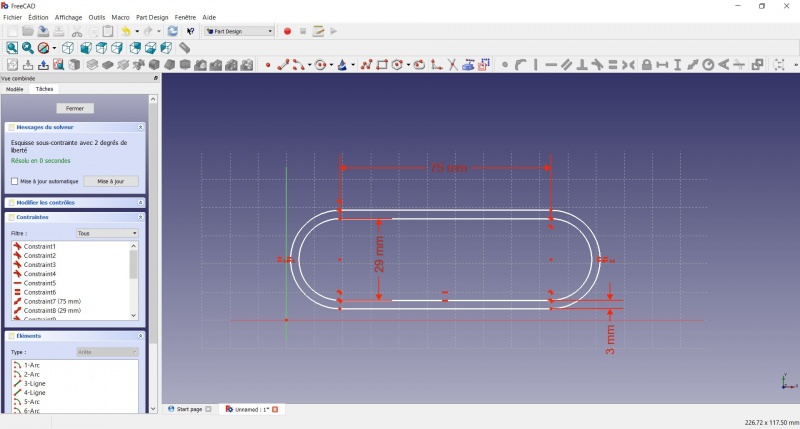
- To make the sketch fully constrained
- Click on the lower left point of the second slot
- Click on the origin of the XY plan
- Click on
 Coincident
Coincident
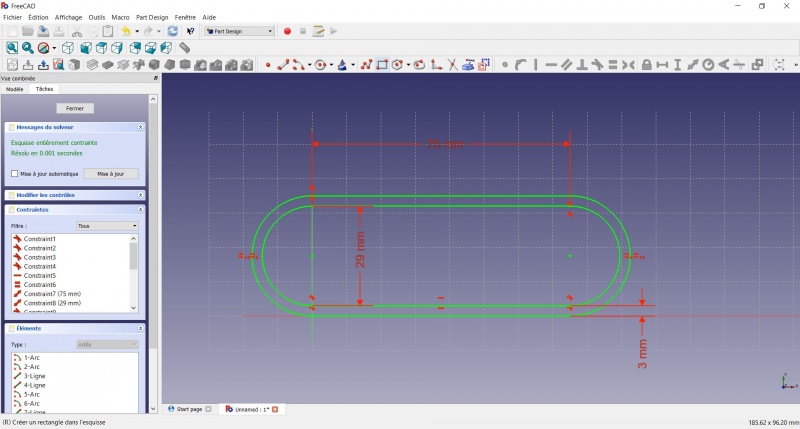
- To leave the sketch, click either on the "Close" button on the left, or the
 icon in the toolbar, or press ESC.
icon in the toolbar, or press ESC.
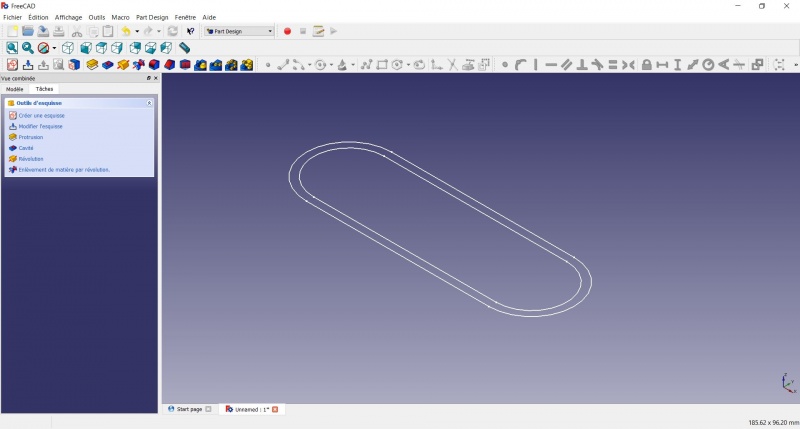
Create a pad
- Click on
 Axonometric among the standard views, to better see what will happen.
Axonometric among the standard views, to better see what will happen. - Click on
 Pad.
Pad. - Enter 30mm and click OK.
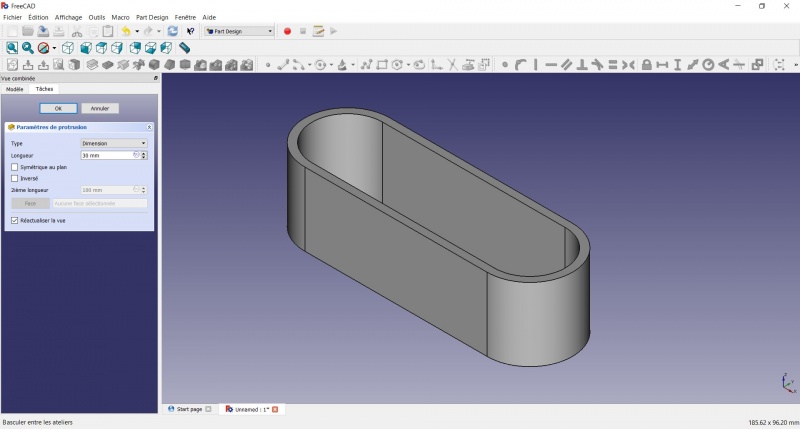
Create a sketch on it
- Select the upper face
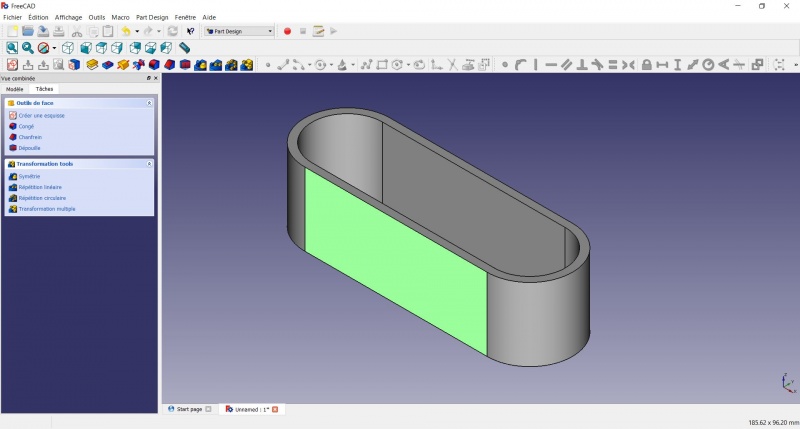
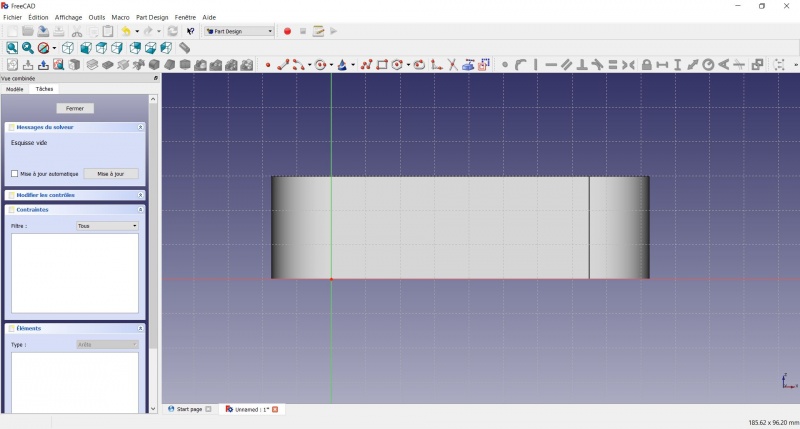
- Draw an
 Hexagon
Hexagon
- Click to place the center
- Move to define the radius
- Click to set
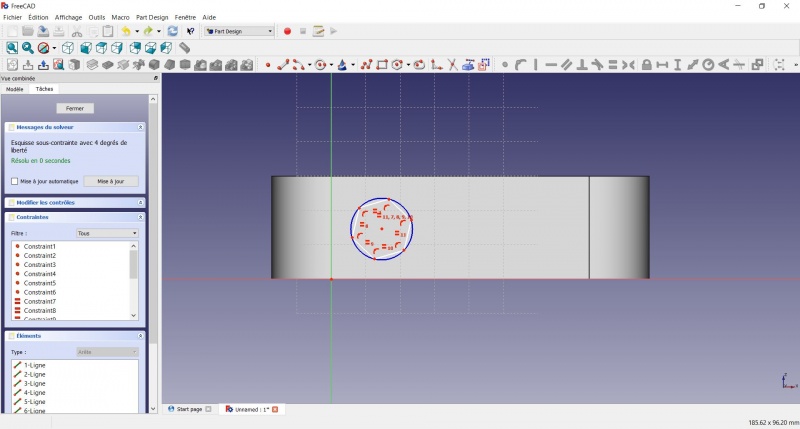
- Click on an edge of the hexagon
- Click on
 Horizontal
Horizontal
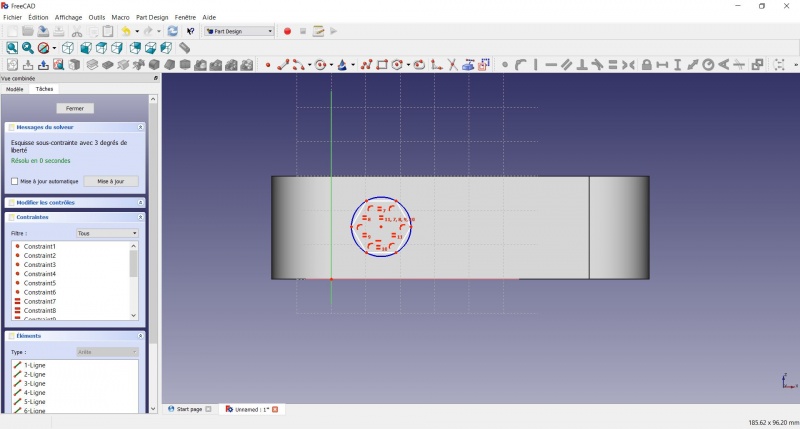
- Click on the center of the hexagon
- Click on the horizontal line of the XY plane
- Click on
 Length
Length - A dialog prompts you to set a dimension. Enter 15mm, click OK.
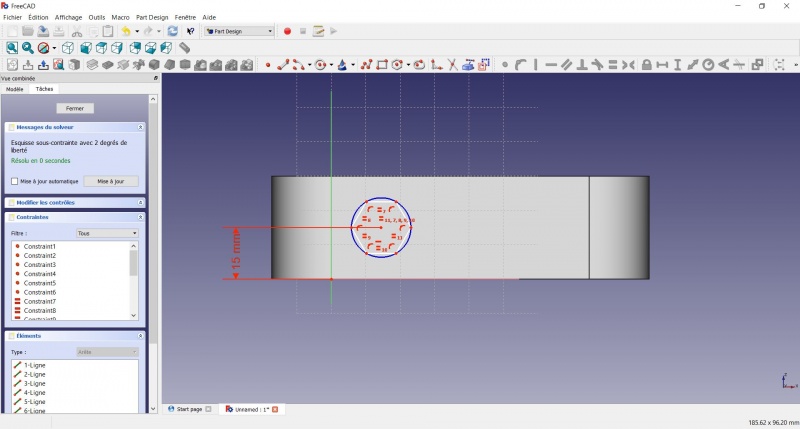
- Click on the center of the hexagon
- Click on the vertical of the XY plane
- Click on
 Length
Length - A dialog prompts you to set a dimension. Enter 10mm, click OK.
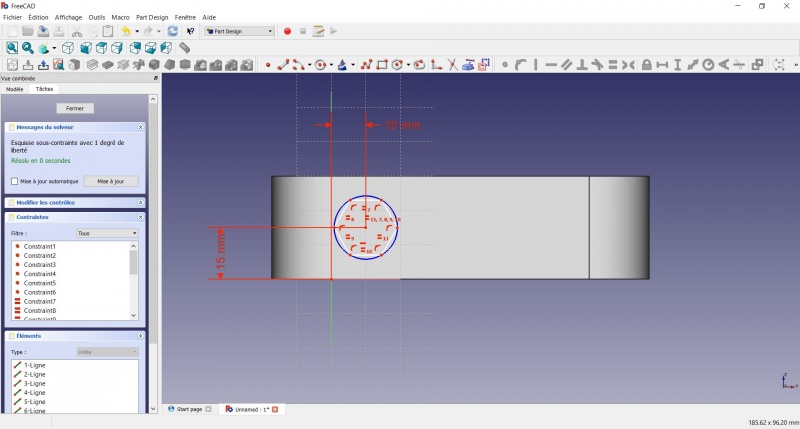
- Click on the blue circle of the hexagon
- Click on
 Radius
Radius - A dialog prompts you to set a dimension. Enter 8mm, click OK.
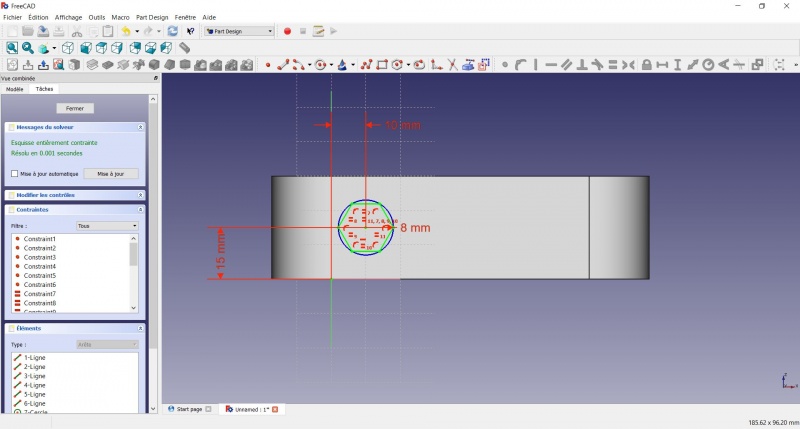
- To leave the sketch, click either on the "Close" button on the left, or the
 icon in the toolbar, or press ESC.
icon in the toolbar, or press ESC.
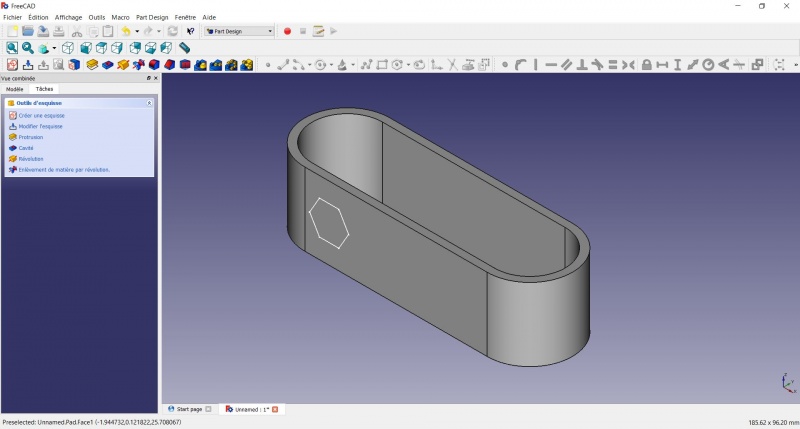
Create a hole
- Click on
 Axonometric among the standard views, to better see what will happen.
Axonometric among the standard views, to better see what will happen. - Click on
 Pocket.
Pocket. - Select to the first in the dropdown menu and click OK.
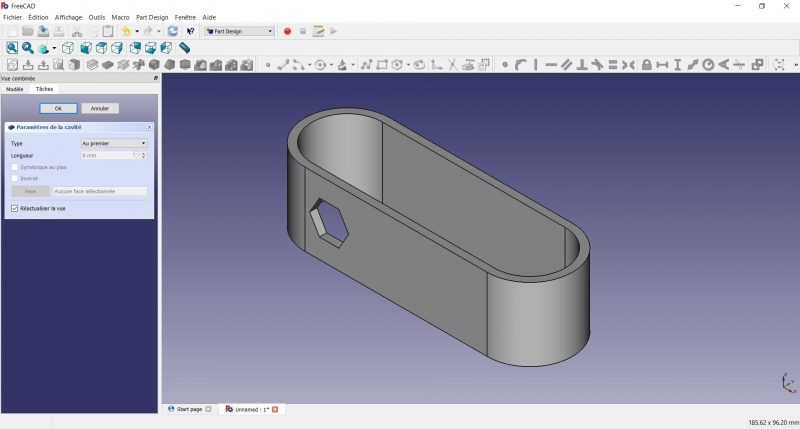
Linear repetition
- In the Combo View on the left, select the tree view instead of the contextual task menu, click on the pocket feature.
- Click on
 LinearPattern.
LinearPattern. - Set the length at 55mm and occurencies at 3, then click OK.
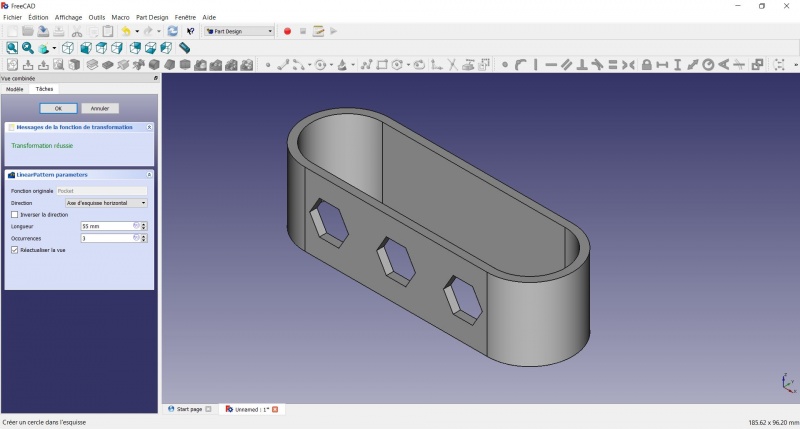
Create a sketch on it
- Select the inner face
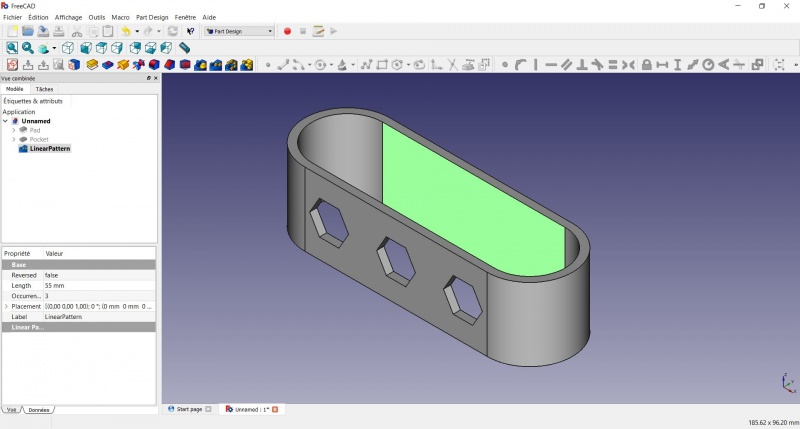
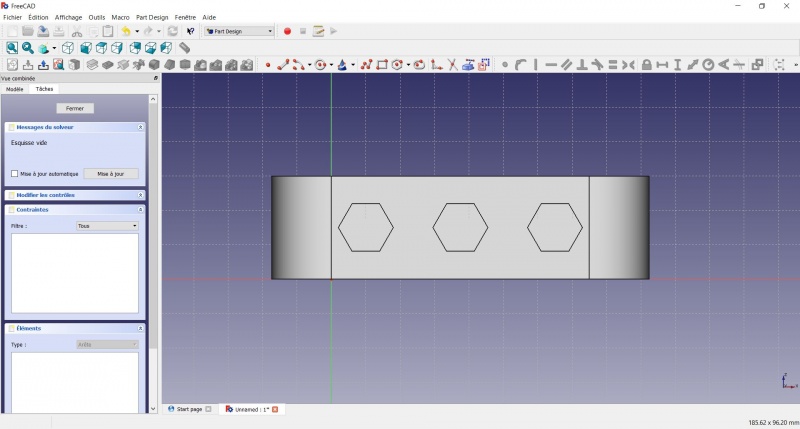
- Click on
 Circle, click to place the center, move the pointer and click to define the radius.
Circle, click to place the center, move the pointer and click to define the radius.
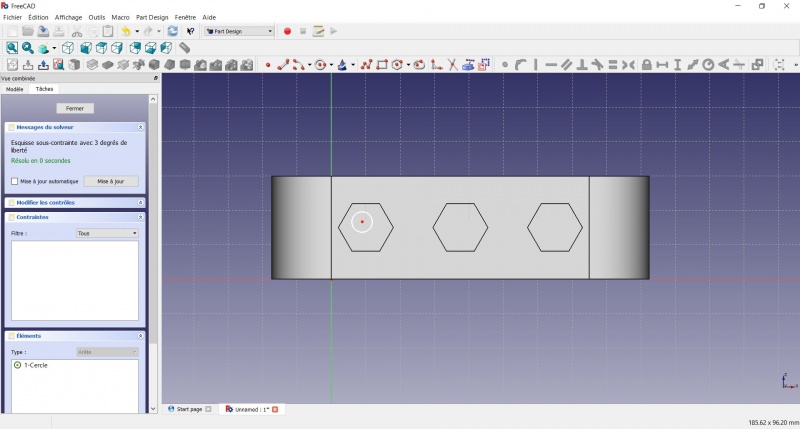
- Click on the center of the circle
- Click on the horizontal line of the XY plane
- Click on
 Length
Length - A dialog prompts you to set a dimension. Enter 15mm, click OK.
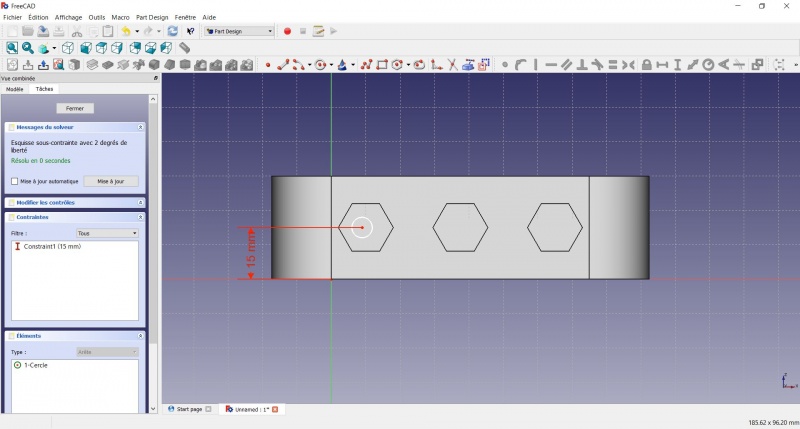
- Click on the center of the circle
- Click on the vertical of the XY plane
- Click on
 Length
Length - A dialog prompts you to set a dimension. Enter 10mm, click OK.
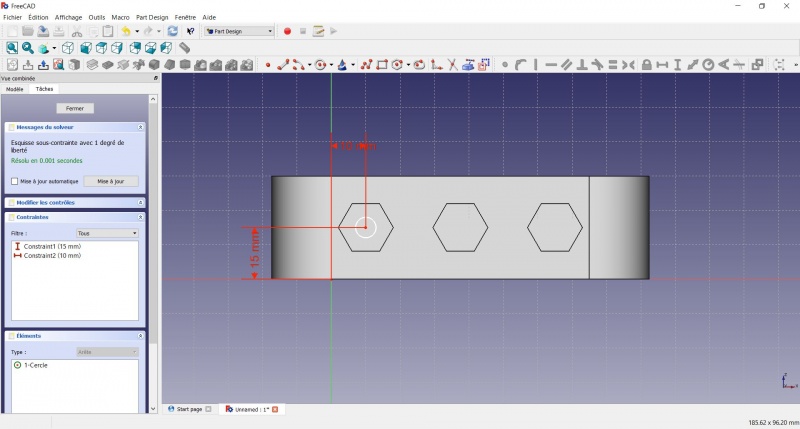
- Click on the circle
- Click on
 Radius
Radius - A dialog prompts you to set a dimension. Enter 3.5mm, click OK.
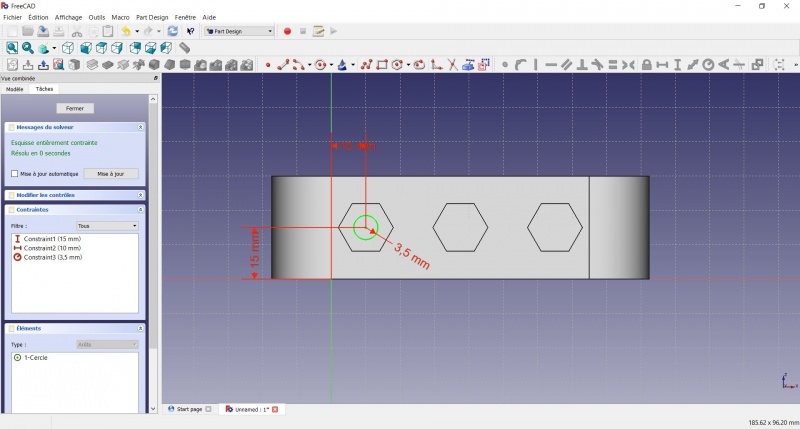
- To leave the sketch, click either on the "Close" button on the left, or the
 icon in the toolbar, or press ESC.
icon in the toolbar, or press ESC.
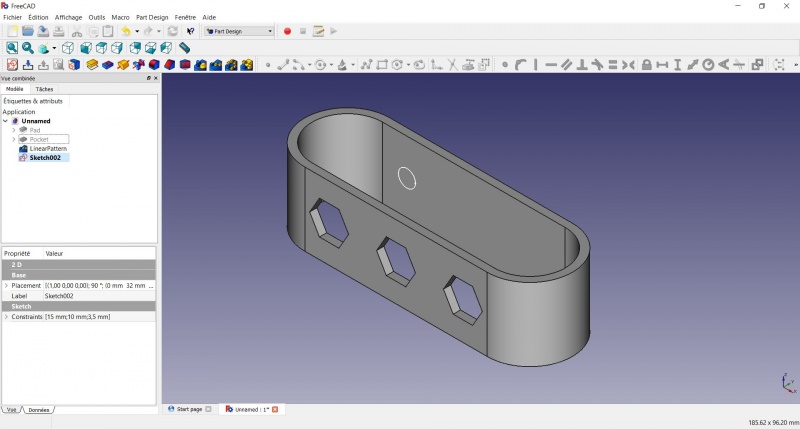
Create a pad
- Click on
 Axonometric among the standard views, to better see what will happen.
Axonometric among the standard views, to better see what will happen. - Click on
 Pad.
Pad. - Enter 4mm and click OK.
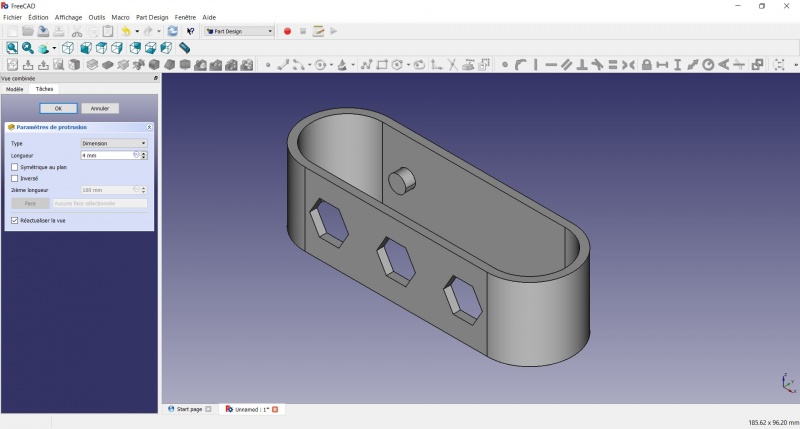
Linear repetition
- In the Combo View on the left, select the tree view instead of the contextual task menu, click on the pad feature.
- Click on
 LinearPattern.
LinearPattern. - Set the length at 55mm and occurencies at 3, then click OK.
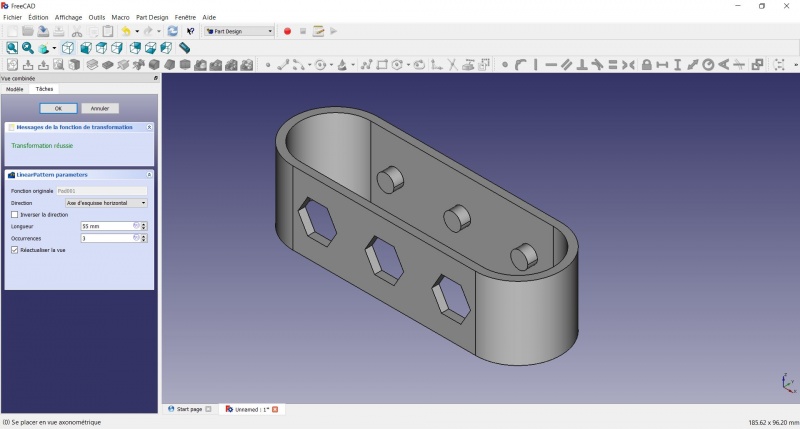
Draft
- Select the side of each round pads
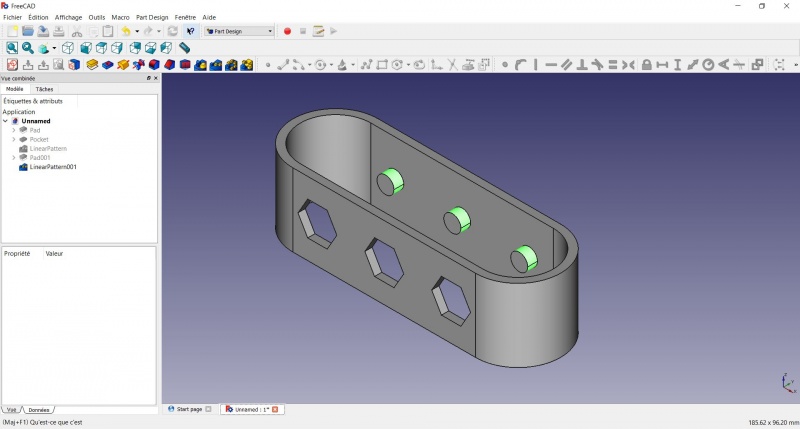
- Click on
 Draft.
Draft. - Set the draft angle at 40°.
- Click on "Neutral plane" and select the face on which the sketch is drawn.
- Tick "Invert the draft direction".
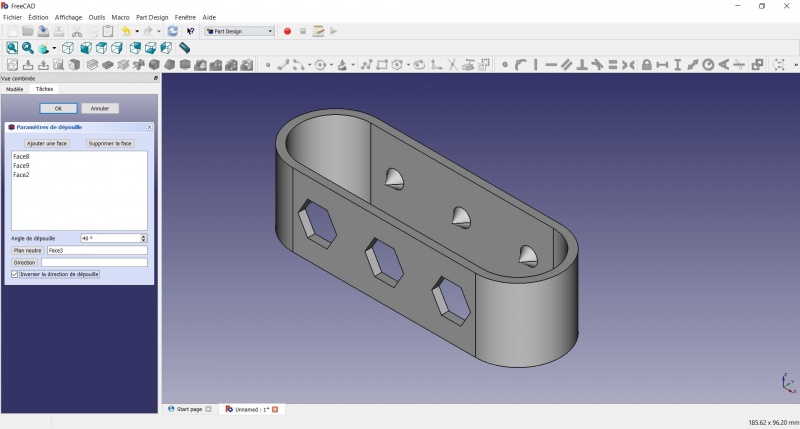
We could have used a chamfer to do something similar, but the draft is more appropriate in this case.
Chamfer = left / Draft = right
Finitions
- Holding CTRL select the bottom and top faces.
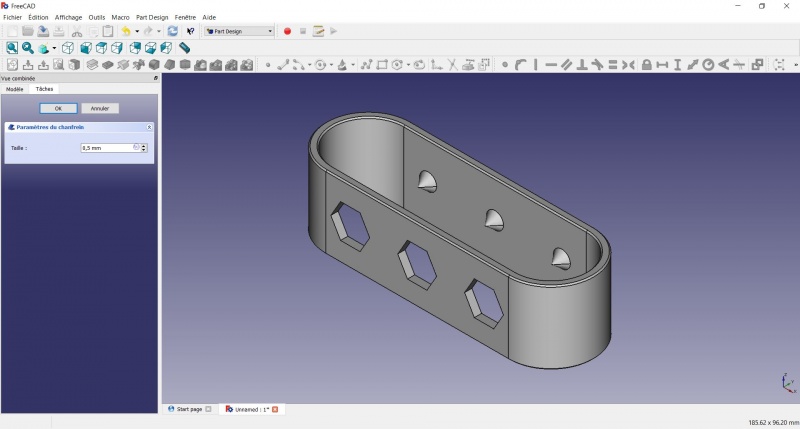
Perfect !
Export as a .STL
- In the Combo View on the left, select the tree view instead of the contextual task menu, click on the last feature (the chamfer).
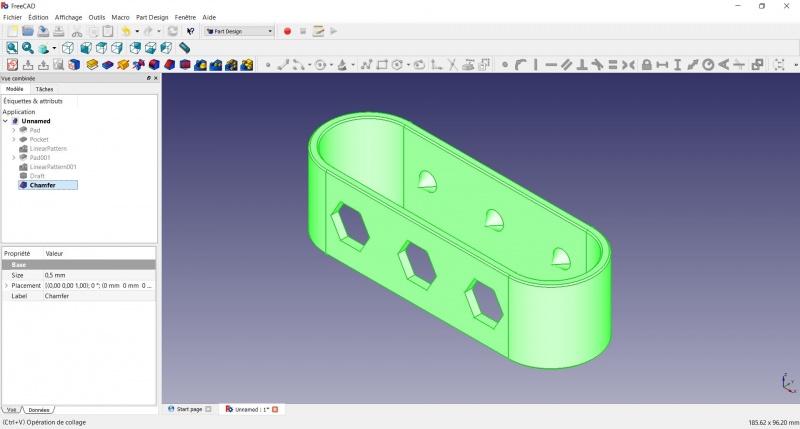
- Now you can select "Export..." from the File menu at the top left, and select the file format .STL.
- Print it instead of the first version or to replace it if it eventually broke ;-)
